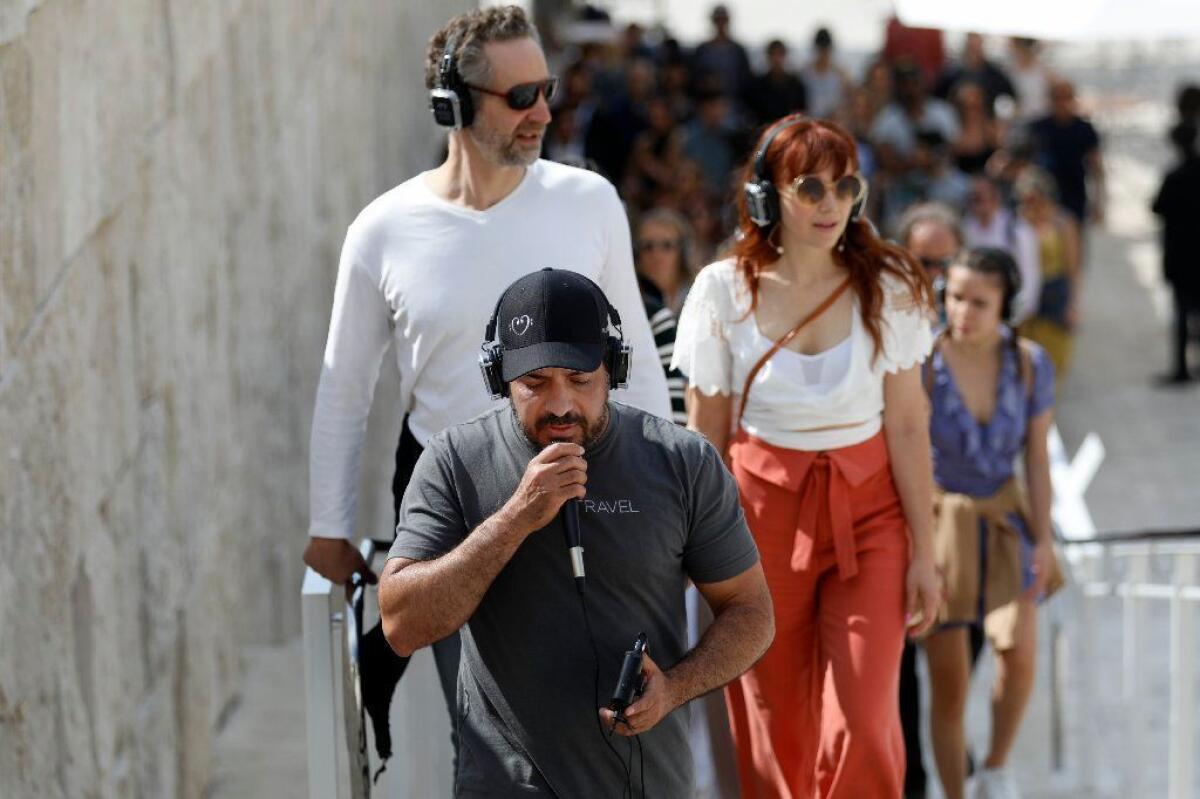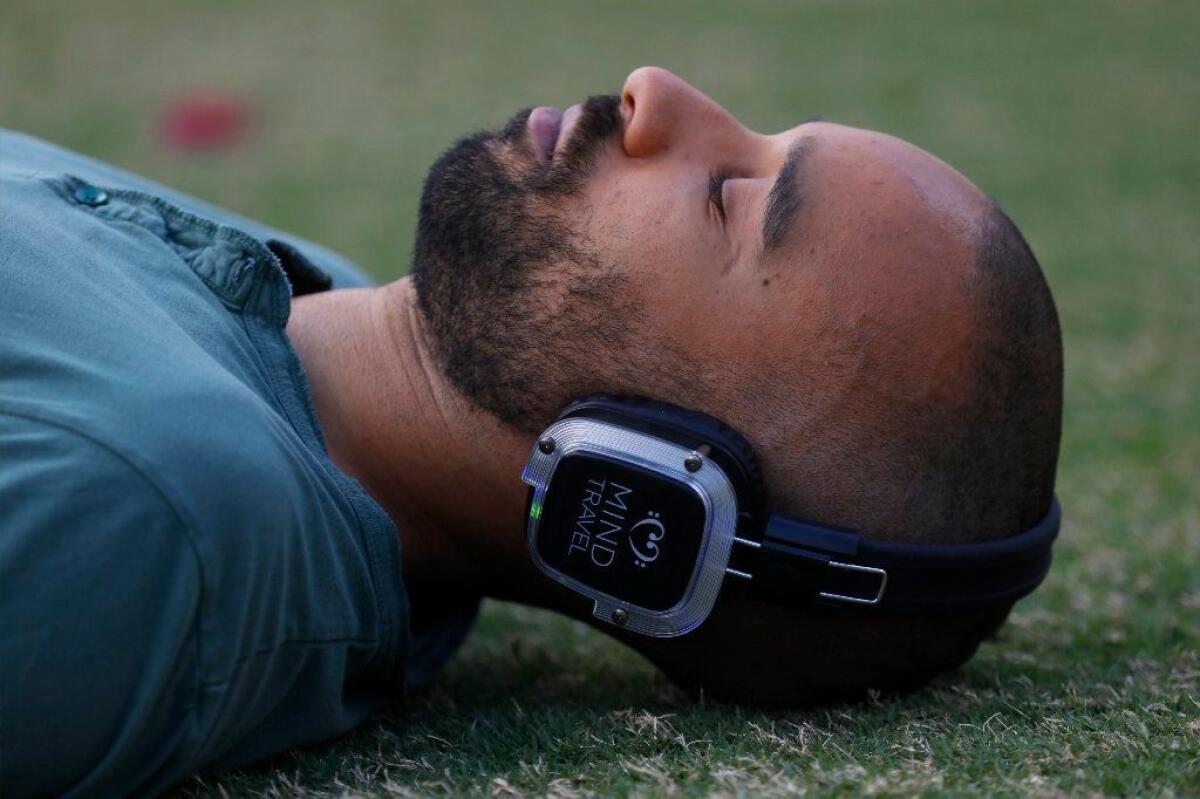MindTravel events are musical trips into mindfulness. I tried one at the Getty

- Share via
It’s the weekend. Feeling like maybe going for a walk or a hike? How about listening to a little music, or seeing some art? Maybe relax and find some peace and stillness. Perhaps you want to connect with others or, if you’re feeling ambitious, with yourself? How about taking it to another level to tap into your unconscious, heal past wounds and discover your purpose in life?
What if you could do all of these at the same time?

In a MindTravel event at the J. Paul Getty Museum, a group puts on headphones and embarks on a two-hour tour of the galleries, grounds and gardens while listening to music.
That’s not really what I was planning when I went to the J. Paul Getty Museum for a MindTravel event last month. Yes, I wanted to see some art and enjoy a lovely Saturday afternoon. I didn’t know my world was about to get rocked. But as I met with the MindTravel group and put on headphones to embark on a two-hour tour of the Getty galleries, grounds and gardens while listening to original music and a guided visit — not so much of the paintings but of my inner life — being rocked pretty much sums up what happened.
“My mission is to move people to greater purpose in their lives through music,” Murray Hidary, the founder and creator of MindTravel, told me a few days after my Getty experience. For the last five years MindTravel has taken thousands of people on journeys to open up consciousness states beneath the surface, all while enjoying a pleasant combination of nature, music, art and relaxation on the surface. MindTravel experiences take place in concert halls, museums and parks, on silent walks and hikes, on the beach in Santa Monica, on Crissy Field in San Francisco, in the Olympic pool in Culver City, or walking across the Brooklyn Bridge in New York, among other sites.
But the real action happens internally. Hidary, a composer, concert pianist, cellist, visual artist, tech pioneer, entrepreneur and physics lover, created MindTravel as a way to combine not only his mastery of all of the above but also to share what he developed as a way to expand our perception of the world and ourselves by combining art, nature, music, voice, silence and experience. The result is introspection, connection and emotional healing, whether you want it or not. “It’s not just transportive,” Hidary said. “It’s a transcendent experience.”

Transcendence is exactly what happens for some people. Sarah Puil, a senior vice president at an experiential branding agency in San Francisco, went to a MindTravel event for the first time six weeks after having a child with her husband. “It was one of the most therapeutic experiences I’ve ever had,” Puil said. “At that time I was like, ‘What am I doing with this baby? Who am I? What is my identity?’ It was the perfect opportunity for me to let go and explore what this new universe meant for me,” Puil said. “Postpartum [depression] is really real. He maybe saved my life.”
Raised in an Orthodox Jewish community in Brooklyn, Hidary realized at an early age that he was not cut out for the life his family imagined for him. So, after his first year at NYU, and without telling his parents, he bought a one-way ticket on Qantas. First stop? Fiji, where he spent four months on an island with no running water or electricity. For a year, he traversed 10,000 miles with his camera, tent and sleeping bag — and occasionally a bike — learning how to choose the right insects to eat, sleep on the side of the road and play the Thai flute along the way. “It was a true coming of age, a true spiritual awakening,” Hidary said.
After returning to NYU and still graduating with his class, he went on to become a tech pioneer, creating one of the earliest websites, one designed to help support organized relief efforts in Rwanda. His next venture involved digitizing the entire catalog of the Metropolitan Museum of Art on his site called EarthWeb.com. By 27, he and his brother had taken their first tech company public; they later launched and sold two more.

And then there is his music. As a child he played cello and then piano and, by the time he was in high school, he knew he wanted to be a composer. At age 33, Hidary wrote and recorded his first symphony in St. Petersburg, Russia. But when MindTravel became a platform for performance — his — he decided to up his game to concert-pianist level. He was living in New York City, and though he would play the piano for hours every night in his Tribeca apartment to de-stress, he craved less distraction (Jay-Z was his neighbor and he says he used to run into Beyoncé in the elevator all the time, for example). So, he moved to Los Angeles.
When he plays the piano during a MindTravel event (the beach, parks and concert halls involve his live music; the silent hikes and walks play his recorded music while he speaks), he composes on the spot according to his feelings and the surroundings. The music is piped into headphones through a radio transmitter he sets up at the venue. Hidary calls this “part musical journey, part meditation through music.”
But this is not typical meditation. Sara Ivanhoe, a yoga and meditation teacher, and a friend of Hidary’s since the late ’90s, said, “It’s more like, ‘Let’s get comfortable exploring and being present with the evolving world, whatever that may be.’ That’s the skill we need for life, not to stop and meditate, but tools to help us navigate what life throws at us.”
You might think that being at a museum with headphones on would feel solitary, but it ends up being oddly connecting. “It’s both an individual practice and a collective shared experience,” said Laura Lekkos, who is pregnant and took the Getty MindTravel journey with husband Dimitri. “You’re in your own thought bubble but doing it with a group, so it’s a communal experience. That duality is pretty interesting to me.”

Hidary said it’s a personal practice first, because you can’t make any difference out in the world unless you change yourself first, but there is a ripple effect.
“Self-connection is how MindTravel all started,” Hidary says. At the time he began exploring music and its larger impact, he was grieving from the loss of his sister, whom he had seen die in a motorcycle accident in South Africa.
“After the death of my sister, I thought, ‘How do I deal with this?’ I was looking at those layers, emotional, physical, spiritual, and knew I needed to address each of them to get through it.” So he used music to “tackle the emotional level to get this pain out of me. I have no words to express it. Music can fill that role — it’s such a complicated and magnificent language of expression.”
He explained that though he used music to get through the most unimaginable tragedy in his life, we all experience micro-traumas every day, from getting cut off on the 405 to a friend speaking to us in a hurtful way. So it’s important to tend our emotional gardens so we don’t carry anger into the world. “There are paths to do that work,” he said. “I’ve never found anything more powerful than music.”
Hidary was determined to transform his pain into beauty and make a real difference. “That’s where all this comes from,” he said. In the past year he created the MindTravel Foundation to serve those dealing with grief and trauma. He brings MindTravel events to at-risk adolescents, veterans, homeless and low-income senior centers (for example in Santa Monica) filled with “rampant loneliness.” With the help of volunteers, MindTravel headsets with Hidary’s recorded or live music are placed on the residents. They light up. Hidary said, “That’s the mission — not just to bring purpose but to bring healing.”

As for my own MindTravel experience, I did travel through the weed-filled gardens of my emotions, re-experiencing feelings that just maybe I buried on purpose but that resurfaced to embolden me to do more than turn on Netflix (research!) that night. On the way home from the Getty, I did get cut off on the 405, but then I slept 11 hours.
By the next morning, the world really did seem a better place.
Essentials
Tickets for the Getty SilentWalk were $20 per person (admission to the Getty is free). The next MindTravel events in the L.A. area are a “silent piano experience” and SilentHike at the Spiritual Glamper in Malibu on June 15 ($75) and an “underwater music experience” at the Culver City Plunge on June 16 ($35-$50). More details can be found on the MindTravel website: www.mindtravel.com.






